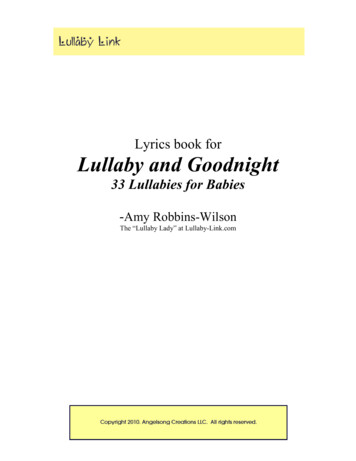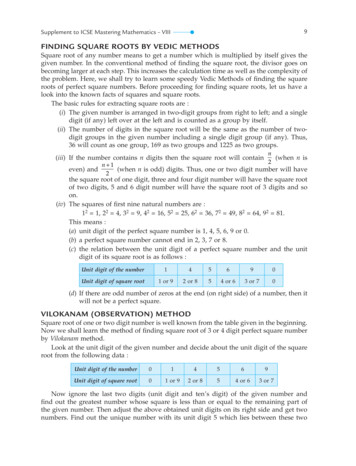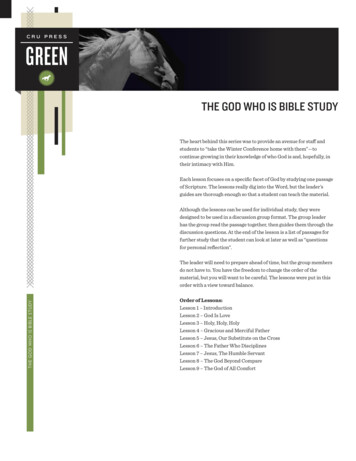
Transcription
2nd Grade: Finding God’s PromisesCopyright 1990, 2004 by Positive Action For Christ , Inc., P.O. Box 700, 502 W. Pippen, Whitakers, NC27891.All rights reserved. No part may be reproduced in any manner without permission in writing from thepublisher.First Edition Published 1990Second Edition Published 20042nd Printing 2008Printed in the United States of AmericaISBN: 0-929784-13-9Author: Cherie NoelCurriculum Consultant: Helen BoenEditor: Steve BraswellLayout and Design: Shannon BrownArtwork: Julie SpeerPublished by
PrefacePrefaceThe primary goal throughout the Positive Action Bible Curriculum is to make the Word of God moremeaningful to the lives of your students. After working with elementary students for many years andusing a variety of curriculum approaches, I found that my students had mastered a lot of material andfactual knowledge at a relatively young age without really having seen the truth of the Scriptures atwork in their lives.It is my desire through this curriculum to have students find knowledge, wisdom and understandingfor themselves from the Word of God. It is my goal that they learn that the Word of God can teachthem how to live from their earliest childhood experiences.Therefore, a key emphasis in this curriculum is establishing students in the Word of God so that theybegin to find answers for themselves. Students will begin during the second semester of first grade tofind easily located Scriptures to answer questions. Second and third grade students will focus on aspecific book of the Bible and follow the story line through the book to find scriptural truth. Fourththrough sixth grade students will be able to use the entire Bible as their source with passages fromvarious books used in each lesson.While it is important to begin with the factual knowledge of the Scriptures, students need to go beyondthis to grow in wisdom and understanding. They need to be presented with the kind of material thatwill help them comprehend, discern, apply, analyze and evaluate a variety of concepts for themselves.The material in this series has been written in such a way that it will help students form personalconvictions, supporting these from their own study of God’s Word.In addition, one of the primary goals of this curriculum is to allow the Holy Spirit to work in the livesof the students to “conform them to the image” of Jesus Christ (Romans 8:29). Therefore, a strongemphasis is placed on character development with practical lessons enabling the students to makelife–changing decisions for themselves even at a young age.Character qualities are brought to life by: Studying and defining important character traits.Analyzing the character trait through the life of a Bible character.Answering questions that directly teach students how to practice that character quality.Using a variety of methods including puzzles, artwork, skits, compositions and discussion toresearch and emphasize the character trait.Encouraging the students to make commitments to develop these qualities in their own lives.In order to accomplish these goals, two basic points need to be emphasized. First, teachers must spendthe necessary time in class teaching their students how to use God’s Word to make it apply to theireveryday lives. The teacher must be an integral part of the Bible class, helping students to find answersand to learn how to handle God’s Word for themselves. You cannot assume that the job has beendone simply because the students are left to complete a workbook assignment on their own. Secondly,once lessons are completed, they should be used as a basis for adequate class discussion to make surethat Bible principles are understood and life applications have been made. Facts and general Bibleknowledge may be gained, but adequate discussion will help make these facts more real to the students.There is adequate material and enough variety to keep Bible class interesting and fun. Some studentsmay not be able to comprehend every aspect of each lesson while others may be challenged to completeall the material along with outside projects. The curriculum can thus provide a program to meet theneeds and interests of all students.Most importantly, make Bible the center of the day’s activities with every other activity emanatingfrom this source. Enjoy watching your students grow in the Lord.Mrs. Cherie Noel2nd Grade Finding God’s Promises 3
PrefaceElementary Curriculum Goals And Objectives1. Elementary students will study the entire Word of God for themselves. K-5: Learning About God. This study will teach your children about God throughthe lives of the major characters throughout the entire Bible. Activity ideas will helpchildren comprehend and apply Bible truths. Grade 1: Enjoying God’s Gifts. First graders will focus on the many gifts of loveprovided for us by God. Emphasis will be on aspects of creation, our families, friends,possessions, Jesus Christ and God’s care for us. Grade 2: Finding God’s Promises. Students will study the life of Moses through theBook of Exodus. The promises of God will be evident as the Israelites and their leadersee both victory and tribulation as they learn to trust God. Grade 3: Growing With God. Third grade units will focus on the life of Joseph in theBook of Genesis and on the life of Daniel in the Book of Daniel. Grade 4: Building Life Castles. These studies will include the life of Christ fromthe Gospels; a study of the Holy Spirit from the Gospels, Acts and the Epistles; anunderstanding of how Christian character develops using Paul’s epistles and the life ofPaul from the Book of Acts. Grade 5: Possessing The Land. A survey of the Old Testament is the basis of this study.Beginning in Genesis, students will gain a much clearer perspective of how the storiesof the Old Testament fit together into one pattern. Grade 6: Winning The Race. Drawing from the entire Word of God, sixth gradestudents learn that the principles of God specifically affect their lives. Studies aredrawn from characters in both the Old and New Testaments and the life of Christ. Anoverview of the Book of Revelation is also included.2. Young people will learn that they can find answers in the Word of God for themselves.3. Our Bible curriculum recognizes the various levels and types of thinking skills necessary todevelop the minds of young people. Lesson questions are therefore designed to focus on avariety of thought processes including Knowledge—learning factual knowledgeComprehension—understanding concepts and ideas; seeing sequential patternsDiscernment—discerning truth based on facts and conceptsApplication—using information learned; applying knowledge gained to personal lifeAnalyzing—analyzing information and knowledge from various viewpointsEvaluation—drawing conclusions; interpreting values to form personal decisions andsupporting these decisions4. Scriptures are used as a study guide for the following purposes: To study the history of God’s dealings with mankindTo understand how God thinksTo analyze the lives of Bible characters for personal examples of how God deals withindividualsTo study a variety of Bible topics5. All lessons ultimately focus on the development of internal character as discussed inRomans 8:28-29. Character qualities are brought to life through: Defining the character quality. Analyzing the quality in the life of a Bible character. Completing puzzles that research the truth of the quality. Listening to stories that emphasize the practical uses of the quality.4 2nd Grade Finding God’s Promises
Preface Using a variety of means to further integrate the quality into life (e.g. skits,compositions, artwork, poetry and discussions).6. A pattern of Scripture memorization is developed through: Memorizing passages that are applicable to the students’ lives. Memorizing key passages rather than just single verses. Encouraging families to memorize Scripture together.7. An active prayer life is encouraged through keeping class notebooks on prayer requests andanswers to prayer.8. An understanding of biblical vocabulary is built through the constant introduction,definition and use of biblical terms.9. An understanding of the land of Israel is gained through map work and related skills.Effective Teaching StrategiesClassroom AtmosphereIt’s so important! Teacher, make sure you prepare for success by establishing the right atmosphere inyour classroom. Discussion times are of prime importance as we work through the lessons this year.The atmosphere must encourage our children to be open and feel a part of the discussion process.We want children to be free to share their thoughts, their attitudes and their common problemswithout fear of embarrassment. Make sure that students understand that we do not condone sin,but we must learn to overcome sin.It will be up to each classroom teacher to establish a positive, healthy, accepting class atmosphereso children will be free to share and grow in the Lord. The climate of the class is therefore of primeimportance.Emphasis On Study SkillsIt is easy to present facts and drill this material for mastery. Students, however, need to go beyondthis basic level of thinking. The material for this series recognizes the various levels of thinkingskills. Make certain that concepts are not retained simply as head knowledge but become personalstandards and convictions from the heart.1. Lesson questions are designed to focus on a variety of thought processes including: Knowledge—mastering factual information. Comprehension—understanding concepts and ideas; seeing sequential patterns. Discernment—identifying truth based on facts and concepts. Application—using information learned; integrating knowledge gained to personallife. Analyzing—considering information and knowledge from various viewpoints. Evaluation—drawing conclusions; interpreting values to form personal decisions.2. In order that your students learn to think on these different levels, it is important that thefollowing attitudes be prevalent in your classroom: Become an integral part of your class. Use every opportunity to talk to and work withyour students. Do not assume that because a workbook assignment has been completed and checkedthat a lesson has been learned or that the Lord has worked in a student’s heart. Recognize that factual knowledge cannot be equated with heart conviction. Studentsneed to be guided in their thinking. Help them learn how to analyze material andcome to their own conclusions. Make the discussion time the heart of your Bible class. Spend adequate class discussiontime, and make sure Bible principles are understood and life applications are made.2nd Grade Finding God’s Promises 5
Preface3. It is difficult for many children to go beyond relating to factual information. Often thisis all they have been used to. Do not expect them to handle the types of questions theywill be asked to think through easily, especially if this is new to them. You will have to betheir guide and gradually bring them to the point of thinking through information on adifferent level.Also, be aware of the importance of the use of visuals in communicating ideas to children. The corecurriculum of our lower elementary Bible studies (grades 1-3) may be enhanced by the systematicuse of supplementary visuals such as flannelgraph materials. Perhaps you already have access tothese materials from existing school resources.The following suggestions may help you to involve your students in the thinking process: Complete the first question with your students and let them complete the rest on theirown. This works well with charts and sequential types of exercises. Have students work in pairs, sharing ideas and coming to conclusions together. They canthen share their answers together, which may give them more confidence. Take your students step by step through a series of questions. Let them look up material intheir Bibles and complete answers. When conclusions must be made or concepts analyzed,work on the idea together. Slowly begin to give them more material to cover on their own.Always discuss their answers so they can begin to have more insight into these concepts. Lead students step by step to analyze what they are learning. Do not give them answersbut lead the discussion in a way that will guide their thinking. You may ask a question toguide their thoughts or give them a clue to relate their thinking to the concept at hand. Discuss a particularly difficult concept with your class before they see the lesson. Aftera thorough discussion, have them turn to the lesson and complete it themselves. Have areview discussion afterwards to insure these concepts are understood. Material should never be completed without some type of discussion or follow-up. Thiswill help your students to learn to think on a deeper level as they discover truth theyhad not considered earlier. If this is not done, your lessons will become an academicexercise only and not a convicting spiritual experience. During discussion times, do not bejudgmental of a student’s answers. Accept all reasonable answers, redirecting the emphasisif necessary. Ask pertinent questions to direct their thinking until they can come to aproper conclusion.Note:Do not be discouraged if your students do not easily handle the levels of thinking required at first.Thinking abilities are learned skills. You are teaching students to think about God and how to livefor Him. You will be thrilled as you begin to see your students develop in this area and begin to seeGod work in their lives. You will also see that this level of development will penetrate into everyother subject as well.Character Trait ActivitiesOne of the goals of this curriculum is to allow the Holy Spirit to work in the lives of the studentsto “conform them to the image” of Jesus Christ (Romans 8:29). Therefore, a strong emphasis isplaced on character development with practical lessons enabling the students to make life-changingdecisions for themselves. The following activities should be included as much as possible each weekto cause the trait to become a part of the lives of your students: 6 2nd Grade Finding God’s PromisesIntroduce the character trait and teach the definition.Apply the character trait to that week’s lesson.
Preface Have your students use suggested activities to think about the application of the trait intheir own lives.Encourage students to make commitments to the Lord to make that trait a part of theirlives.Keep the character trait in front of your students as much as possible. Have a place in theroom to write the character trait and its definition each week as a continual reminder toyour students. As situations arise, refer to the trait being studied.Find opportunity in classes outside of Bible to emphasize the character trait. Studentsneed to see character emphasized throughout every area of study. The traits can applyto material in history. Compositions, stories and news reports can be written using acharacter quality as the basis. Character trait activities can also be used to produce artworkof many kinds.As situations in your class or with individual students surface, bring up past character traitsor lessons to reinforce your teachings. The use of the character traits should be ongoinglessons that truly help your children to grow in the Lord on a continual basis.Let parents know the weekly character trait so they can follow up at home as well.Life Application SectionsThe general format of these sections is to enable students to personalize the principles taughtthroughout the week. We want students to form personal convictions based on the Word of God—from “head knowledge to life applications.”Students will therefore be expected to analyze and apply information and draw conclusions fortheir own lives.It is of utmost importance that an atmosphere of acceptance and openness be established. Wedo not want to condone sin but rather to recognize that we all have sin problems to deal with.Children need to feel free, not necessarily to admit sin openly in the classroom, but to discuss areasof common problems.Your children will probably feel somewhat inhibited at first. As you continue to guide their thinkingand use discussion times to share common issues, this section should become the most engrossingactivity of the week.VocabularyNew vocabulary words are introduced on the first page of many of the teacher’s lessons. Go overthe meanings of the words, but do not belabor them, since they will be covered during the week’slesson as well. At times, students will be expected to define vocabulary terms within the body of thelesson. They will also be asked to use them to complete puzzles or answer questions.You may find that you do not need to explain all the vocabulary words that are listed in the teacherlesson. We have tried to identify the more difficult words from the Bible translations that are usedmost often. Depending on which translation you are using, you may not need to explain somewords, or you may find additional words that your students will need to have explained to them.2nd Grade Finding God’s Promises 7
PrefaceWeekly Lesson Plans5-Day WeekDay One:Day Two:Day Three: Introduce new Scripture memory verses for the week.Introduce new vocabulary and discuss.Introduce lesson using ideas from the teacher’s manual.Have students begin working through first section of material.Spend time on hymn for month and choruses.Drill Scripture memory verses for the week.Continue to work through sections of material in student’s manual.Provide discussion time to make concepts well understood.Continue to work on hymn and choruses.Drill Scripture memory verses.Review and drill material from the last two days.Finish lesson including the final section focusing on internal conviction; includediscussion time to make concepts well understood.Introduce character trait for the week with its definition and show how itapplies to the lesson for the week.Drill Scripture memory verses.Give time for extra puzzles, etc. not yet completed in student’s manual.Spend time on character trait activity.Continue to work on hymn and choruses.Check Scripture memory report sheets.Use extra time for sword drill, etc.Use other character trait activities.Spend time on hymn and choruses. Introduce Scripture memory verses and discuss meanings.Introduce vocabulary words.Introduce lesson and assign material for individual work.Work on hymn and choruses for the month.Drill Scripture memory verses briefly.Continue to work through sections in the student’s manual.Provide good time of discussion to make certain that concepts are understood.Introduce the character trait and definition, correlating the trait into the lesson.Sing hymn and choruses.Drill Scripture memory verses.Complete lesson material focusing on final section.Provide good time of discussion.Use character trait activity if you have time.Sing hymns and choruses.Check Scripture memorization report sheets.Spend time on character trait activity. Day Four:Day Five:4-Day WeekDay One:Day Two:Day Three:Day Four:8 2nd Grade Finding God’s Promises
Preface3-Day WeekDay One:Day Two:Day Three: Introduce Scripture memory verses. Introduce vocabulary words. Introduce lesson and allow students to work on assigned material. (Evaluatewhich material you will focus on during the week, and leave the remainder forextra-credit work.) Drill Scripture memory verses. Continue to assign material, working through most of the material togetherand focusing on key ideas and discussing material as it is covered. Discuss the character trait and apply it to concepts learned during week. Check Scripture memory report sheets.Scripture Memory ProgramGoals and Objectives To provide a cyclical Scripture memory program so that verses are memorized at least twiceduring the elementary years To design the Scripture memory program so that families will be concentrating on onlyone set of verses each week To help students memorize passages of Scripture in context rather than isolated versestaken out of context To select a small section of Scripture that can be easily memorized each week withoutdiminishing the importance of Scripture memorization programs used within the localchurch To have parents listen to their children quote Scripture in order to involve the home in thespiritual training of the child To use Scripture that is easily related to the everyday lives of the students and to spend thenecessary time to make these verses “come alive” to the studentsHow To Use The Program1. Each student has a copy of the Scripture memorization report sheet in the student’smanual. This is to be kept at home and brought to school once a week with the parent’ssignature to indicate to the teacher that the verses have been memorized by the student.(This form is provided in both the teacher’s and student’s manuals. You may use the formin their books or make a copy of it.)2. Each week in class, spend time discussing the meaning of the verses that are assignedfor that week. This is of the utmost importance if your Scripture memory program is tobe a success. It would be easy to leave the Scripture memorization in the hands of thestudents, but this would not fulfill all the goals of this program. These Scriptures need tobe adequately discussed, and life applications need to be made.3. As you drill the verses each week, continue to drill and review verses from the passages thatwere learned in previous weeks. We want these verses to become a part of your students’lives so that the principles contained in them will not be forgotten.4. Have your students quote their verses to their parents at home. (Perhaps other arrangementsmight need to be made for some of your students whose parents may not wish to participatein such a program.) This accomplishes two purposes: (1) valuable class time is not spent byyour having to listen to each student quote his or her verses, and (2) the parents becomeinvolved in the spiritual training of the child.2nd Grade Finding God’s Promises 9
Preface5. Notice that review weeks are provided during which the entire passage that has previouslybeen learned can be thoroughly reviewed and quoted as a whole. If your students aredrilled on the verses week by week, quoting the entire passage during this review week willbe easy for most of them.6. The danger in any Scripture memory program is that the children memorize words onlyto meet a deadline and then move on to the next group of words. We should make surethat these Scripture verses become more than just words to our students and then do allwe can to see that they understand their true meaning and make them an integral partof their everyday lives. Design a system that rewards students who demonstrate that theyhave truly memorized all the Scripture for the year.Scripture Memory OptionsSix sets of Scripture memory programs are included in this curriculum. These sets may be used inone of two ways according to what you feel is appropriate for your school.1. Option 1Every year the Scripture memory programs would be the same for each grade. Grade 1—Enjoying God’s Gifts Scripture memory program Grade 2—Finding God’s Promises Scripture memory program Grade 3—Growing With God Scripture memory program Grade 4—Building Life Castles Scripture memory program Grade 5—Possessing The Land Scripture memory program Grade 6—Winning The Race Scripture memory programThe advantage to this option is that you would be using the Scripture memory programs exactly asthey are outlined in the student’s manual.2. Option 2 Year 1 Grades 1-3—Enjoying God’s Gifts Scripture memory program Grades 4-6—Building Life Castles Scripture memory program Year 2 Grades 1-3—Finding God’s Promises Scripture memory program Grades 4-6—Possessing The Land Scripture memory program Year 3 Grades 1-3—Growing With God Scripture memory program Grades 4-6—Winning The Race Scripture memory programThe advantage of this option is that the parents would be able to work with their children on thesame Scripture memory program even if the children were in different grades. (The passages forstudents in grades 1-3 and 4-6 would be similar except that the students in grades 1-3 would bememorizing fewer verses.) Also, with the entire elementary school memorizing verses from thesame passages, these passages could be reinforced by the weekly chapel programs. Thus it wouldserve to coordinate the Scripture memory programs for all elementary grades. On the followingpages, we have provided the Scripture memory forms for all three grades of your level in case youdecide to choose this option.Before you choose this option, please be aware that the Scripture memory program for grade 1 isrelated to the lessons in that study and also includes shorter, simpler verses. If you choose optiontwo, then the year you use the grade 1 Scripture memory program for grades 1-3 you may wish touse the program as is for grade 1 but make some adjustments in the program for grades 2 and 3 tomake it more challenging for them.10 2nd Grade Finding God’s Promises
Enjoying God’s Gifts Scripture Memorization Report SheetName: Grade: Teacher:WeekScripture1Gen. 1:12Gen. 1:31a3Eph. 6:14Eph. 6:25Eph. 6:1-26Eph. 6:1-37Gen. 9:11c8Gen. 12:2a9Gen. 28:15b10Review11Prov. 3:512Prov. 3:613Prov. 3:5-614Luke 1:4915Luke 2:716Luke 2:1117Luke 2:5218Review19Matt. 4:1920Luke 18:1621Eph. 4:3222Matt. 14:27b23Mark 10:52a24John 10:1125John 3:1626Review27Psalm 23:128Psalm 23:229Psalm 23:330Psalm 23:1-331Psalm 23:432Psalm 23:533Psalm 23:634Psalm 23:4-635Psalm 23:1-6Due DateParent’s Signature
Finding God’s Promises Scripture Memorization Report SheetName: Grade: Teacher:WeekScripture1Eph. 6:112Eph. 6:123Eph. 6:11-124Eph. 6:135Eph. 6:146Eph. 6:157Eph. 6:168Eph. 6:179Eph. 6:13-1710Eph. 6:1811Eph. 6:1912Eph. 6:2013Eph. 6:18-2014Psalm 119:915Psalm 119:1016Psalm 119:1117Psalm 119:1218Psalm 119:9-1219Psalm 119:1320Psalm 119:1421Psalm 119:1522Psalm 119:1623Psalm 119:13-1624Psalm 119:9-16251 John 4:7261 John 4:8271 John 4:7-8281 John 4:9291 John 4:10301 John 4:9-10311 John 4:7-10321 John 4:11331 John 4:12341 John 4:13-14351 John 4:11-14Due DateParent’s Signature
Growing With God Scripture Memorization Report SheetName: Grade: Teacher:WeekScripture1Matt. 5:1-22Matt. 5:3-43Matt. 5:5-64Matt. 5:1-65Matt. 5:7-86Matt. 5:9-107Matt. 5:11-128Matt. 5:7-129Matt. 5:1-1210Prov. 3:1-211Prov. 3:3-412Prov. 3:1-413Prov. 3:5-614Prov. 3:7-815Prov. 3:9-1016Prov. 3:5-10171 Thes. 4:13181 Thes. 4:14191 Thes. 4:15201 Thes. 4:16-17211 Thes. 4:18221 Thes. 4:13-1823James 1:124James 1:2-325James 1:426James 1:527James 1:628James 1:1-629John 14:130John 14:231John 14:332John 14:433John 14:534John 14:6-735John 14:1-7Due DateParent’s Signature
PrefaceMusic CurriculumThe purpose of having an outline for music is to make sure students learn a variety of songs andthat new music is continually being introduced to our students. It is good that students continueto sing songs with which they are very familiar, but we also believe it is important that they beginto learn the traditional hymns of the faith.We introduce one hymn a month for our students to learn. (In grades one and two, some hymnsare studied for two months.) Al Smith’s Treasury of Hymn Histories is the source we use because thebackground of the hymn and often the writer is presented. This background information will makethe meaning of the song even more significant to you and your students. Introduce the hymn byreading its story from Hymn Histories at the beginning of the month. Then go over the meaningof the words to the song, perhaps even having your class look up some of the words in a dictionary.Then decide how many verses of the hymn you will encourage your students to memorize.In addition to the monthly hymn, two choruses from Sing And Be Happy are introduced eachmonth. The only month in which a hymn is not suggested is December since it is usually given overto Christmas music. Children should spend time each month singing favorite choruses they alreadyknow and continuing to review choruses learned earlier in the year. The new choruses should also beintroduced and memorized. Two new choruses should be the maximum number introduced eachmonth, and you may find that you only need to introduce one. The important thing to rememberis the need to continually introduce new choruses to your students in a systematic fashion.The following two books are the resources needed for this music curriculum. Both books may beordered through Positive Action for Christ, P.O. Box 700, Whitakers, NC 27891.Smith, Alfred B. Sing And Be Happy. Greenville, South Carolina: Better Music Publications,1986.Smith, Alfred B. Treasury of Hymn Histories. Greenville, South Carolina: Better MusicPublications, 1985.Second Grade Music CurriculumMonthHymn (From Hymn Histories)Choruses (From Sing And Be Happy)September“Living For Jesus,” p. 116“Jesus Loves The Little Children,” #116October“Living For Jesus,” p. 116“My Sins Were Rising High, High, High,” #11“Happy Little Children,” #13November“Draw Me Nearer,” p. 94“Father We Thank Thee,” #17“You Will Outshine The Sun,” #20DecemberSing Christmas carols“Jesus, Once An Infant Small,” #102January“My Redeemer,” p. 208“Noah And The Ark,” #48February“My Redeemer,” p. 208“It’s All Right Now,” #5“The Birds Upon The Tree-tops,” #119March“When The Roll Is Called Up Yonder,” p. 235 “I Am The Door,” #56“Jesus Bids Us Shine,” #59April“When The Roll Is Called Up Yonder,” p. 235 “Jesus Came Down,” #73“All Of My Burdens Went Rolling Away,” #75MayReview four hymns already learned14 2nd Grade Finding God’s Promises“All Your Heart,” #28“I Have Jesus In My Heart,” #63
ContentsUnit OneGod Gives Us PromisesLesson 1Trusting
Apr 02, 2013 · 2nd Grade Finding God’s Promises . The primary goal throughout the Positive Action Bible Curriculum is to make the Word of God more meaningful to the lives of your students. After working with elementary students for many years and using a variety of curriculum approaches, I










